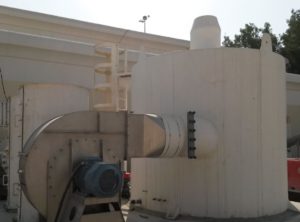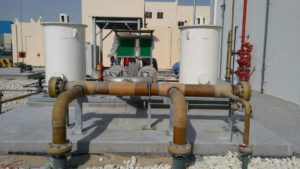Various activated carbon systems for Doha pumping stations
Because of the continuous expansions in Doha-Qatar, several pumping stations were upgraded in the last 5 years. IPEC odour control systems of varying sizes were installed in each of the seven pumping stations within the project CP725.
In each pumping station, the odour control unit is provided as a full duty-standby system. So the system exists out of 2 trains working completely independent. Each train exists out
- Prefilter for dust and mud removal
- Demister for droplet separation
- Centrifugal fan
- Activated carbon system
 The prefilter is the first step in the air treatment and must filter dust and other solids from the ventilated air. The prefilter is provided with a delta pressure control and an automated spraying system for in situ cleaning of the prefilter tissue. The prefilter tissue is installed in a cassette which is easy to remove for replacement.
The prefilter is the first step in the air treatment and must filter dust and other solids from the ventilated air. The prefilter is provided with a delta pressure control and an automated spraying system for in situ cleaning of the prefilter tissue. The prefilter tissue is installed in a cassette which is easy to remove for replacement.
After the prefilter, the demister is installed which removes the droplets from the air by a fine knitted demister package. The knitted mesh has a low pressure drop and is very efficient for droplet removal. The demister package is also placed in a retractable stainless steel cassette for easy access.
For this project, special attention was paid to the fact that the indoor climate of the pumping station was good enough to allow people to enter the screening area and the wet well without a health or safety risk. To obtain an acceptable low H2S-concentration in the accessible chambers, a sufficient ventilation rate must be maintained. In case of man entry the ventilation rate is increased to 33 airchanges. The air extraction is done by a direct driven stainless steel fan. This sturdy fan has a low energy consumption and will produce less noise comparing to belt driven fans. The mayor advantage of a stainless steel fan over a GRP-fan is the robustness of a stainless steel fan. The fan is frequency controlled by a variable frequency drive (VFD) to be able to set the required flow of the OCU.
 Depending on the required flow, the carbon vessels are executed as vertical single bed vessels or as vertical double bed vessels. The biggest pumping station with a flow of more than 30 000 m³/hour and more than 8 MT of activated carbon. The activated carbon provided in these systems is catalytic activated carbon. This carbon has the catalytic property to absorb H2S and to convert H2S into H2SO4 (sulphuric acid). Once the carbon is saturated, the sulphuric acid can be washed from the carbon to restore the adsorption capacity. This procedure of washing (regeneration) can be done in situ by the spraying system.
Depending on the required flow, the carbon vessels are executed as vertical single bed vessels or as vertical double bed vessels. The biggest pumping station with a flow of more than 30 000 m³/hour and more than 8 MT of activated carbon. The activated carbon provided in these systems is catalytic activated carbon. This carbon has the catalytic property to absorb H2S and to convert H2S into H2SO4 (sulphuric acid). Once the carbon is saturated, the sulphuric acid can be washed from the carbon to restore the adsorption capacity. This procedure of washing (regeneration) can be done in situ by the spraying system.
IPEC can supply all kind of activated carbon systems, starting from very small units with the fan mounted on top up to installations with high flows (75 000 m³/hour) in vertical or horizontal bed with full automated regeneration, skada connections, etc.